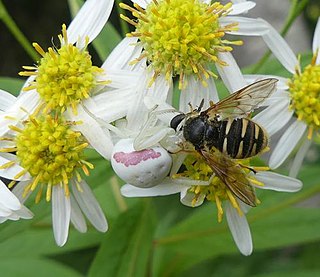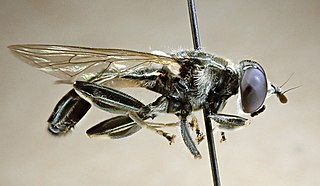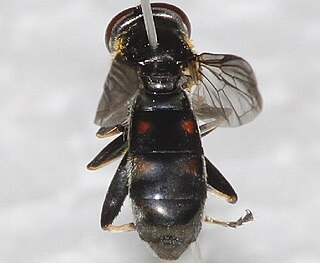
Hover flies, also called flower flies or syrphid flies, make up the insect family Syrphidae. As their common name suggests, they are often seen hovering or nectaring at flowers; the adults of many species feed mainly on nectar and pollen, while the larvae (maggots) eat a wide range of foods. In some species, the larvae are saprotrophs, eating decaying plant and animal matter in the soil or in ponds and streams. In other species, the larvae are insectivores and prey on aphids, thrips, and other plant-sucking insects.

Eristalinae are one of the four subfamilies of the fly family Syrphidae, or hoverflies. A well-known species included in this subfamily is the dronefly, Eristalis tenax.

Sericomyia chrysotoxoides ,, the Oblique-banded Pond Fly , is a common species of syrphid fly observed across the eastern half of North America and in the Rocky Mountains. Syrphid flies are also known as Hover Flies or Flower Flies because the adults are frequently found hovering around flowers from which they feed on nectar and pollen. Adults are 9.6–1,315.3 mm (0.38–51.78 in) long, black with yellow bands, less prominant in the male. The larvae of this genus are known as rat tailed maggots for the long posterior breathing tube.

Sericomyia militaria ,, the Narrow-banded Pond Fly , is a common species of syrphid fly observed across northern North America. Syrphid flies are also known as Hover Flies or Flower Flies because the adults are frequently found hovering around flowers from which they feed on nectar and pollen. Adults are 11.7–17.1 mm (0.46–0.67 in) long, mostly black with narrow yellow abdominal markings. The larvae of this genus are known as rat tailed maggots for the long posterior breathing tube.
Cynorhinella longinasus ,, the Eastern Longnose Fly, is a rare species of syrphid fly observed in New York, Pennsylvania and the New England States Syrphid flies are also known as Hover Flies or Flower Flies because the adults are frequently found hovering around flowers from which they feed on nectar and pollen. Adults are 5.5–7 mm (0.22–0.28 in)long, black with a distinct conical projecting face. The larvae are unknown.

Teuchocnemis lituratus ,, the The Black Spur Fly , is an uncommon species of syrphid fly observed in the eastern half of North America. Syrphid flies are also known as Hover Flies or Flower Flies because the adults are frequently found hovering around flowers from which they feed on nectar and pollen. Adults are 10.5–15.4 mm (0.41–0.61 in)long, black with a yellow scutellum and hind tibia of male with spike. The larvae are unknown.

Sericomyia transversa , the Yellow-spotted Pond Fly , is an uncommon species of syrphid fly observed in northeastern North America.. Hoverflies can remain nearly motionless in flight. The adults are also known as flower flies for they are commonly found on flowers, from which they get both energy-giving nectar and protein-rich pollen. The larvae of this genus are known as rat tailed maggots for the long posterior breathing tube.

Helophilus fasciatus, the narrow-headed marsh fly, is an abundant species of syrphid fly observed throughout the United States and Canada. Hoverflies can remain nearly motionless in flight. The adults are also known as flower flies for they are commonly found on flowers, from which they get both energy-giving nectar and protein-rich pollen. The larvae of this genus are associated with wet decaying organic material, particularly accumulations of decaying vegetation in ponds and mud and farmyard manure or silage. The adults of this species lays eggs on vegetation overhanging water. The larvae hatch and drop into the water.

Parhelophilus flavifacies , the Black-legged Bog Fly, is a rare species of syrphid fly observed in the Eastern United States and Canada. Hoverflies can remain nearly motionless in flight. The adults are also known as flower flies for they are commonly found on flowers, from which they get both energy-giving nectar and protein-rich pollen. The larvae are the long tailed "rat-tailed" type.

Syrphus knabi, the The Eastern flower Fly, is an uncommon species of syrphid fly observed in the eastern and United States and Canada. Syrphid flies are also known as Hover Flies or Flower Flies because the adults are frequently found hovering around flowers from which they feed on nectar and pollen. Adults are 7.2–12.9 mm (0.28–0.51 in) long. The larvae are predators of a variety of aphids in trees.

Sericomyia bifasciata, the Long-nosed Pond Fly, is an uncommon species of syrphid fly. They have been observed from the northeastern part of North America. Hoverflies get their names from the ability to remain nearly motionless while in flight. The adults are also known as flower flies for they are commonly found around and on flowers, from which they get both energy-giving nectar and protein-rich pollen. The larvae in the genus Sericomyia are known as the rat-tailed with a long breathing tube taylored for aquatic environments. The larvae for this species are unknown.

Eristalis obscura, the Dusky Drone Fly, is a common species of syrphid fly first officially described by Loew in 1866 This species is widespread in the northern part of North America and Europe east to Siberia. Hoverflies get their names from the ability to remain nearly motionless while in flight The adults are also known as flower flies for they are commonly found around and on flowers from which they get both energy-giving nectar and protein-rich pollen. The larvae are aquatic filter-feeders of the rat-tailed type.

Xylota angustiventris,, the Two-spotted Leafwalker , is an uncommon species of syrphid fly observed in northeast North America. Syrphid flies are also known as Hover Flies or Flower Flies because the adults are frequently found hovering around flowers from which they feed on nectar and pollen. Adults are 12.2–14.4 mm (0.48–0.57 in) long, largely black with two yellow spots on the abdomen in the male? The larvae are not known, but in this genus, are likely to be found in tree holes or bark to feed on sap. .
Xylota confusa ,, the Confusing Leafwalker , is an uncommon species of syrphid fly observed across Northern North America. Syrphid flies are also known as Hover Flies or Flower Flies because the adults are frequently found hovering around flowers from which they feed on nectar and pollen. Adults are 9.3–12.6 mm (0.37–0.50 in) long. The larvae of this genus live under bark in sap runs.
Xylota flavifrons ,, the Northern Leafwalker , is an uncommon species of syrphid fly observed in the northeastern United States and all across Canada. Syrphid flies are also known as Hover Flies or Flower Flies because the adults are frequently found hovering around flowers from which they feed on nectar and pollen. Adults are 9.4–14.7 mm (0.37–0.58 in) long. The larvae of this genus live under bark in sap runs.

Xylota hinei , ( ), the Hine's Leafwalker , is an uncommon species of syrphid fly observed in Eastern Canada. Syrphid flies are also known as Hover Flies or Flower Flies because the adults are frequently found hovering around flowers from which they feed on nectar and pollen. Adults are 7.8–12.9 mm (0.31–0.51 in) long, black with yellow spots. The larvae of this genus live under bark in sap runs.
Platycheirus inversus, also known as the knobfoot sedgesitter, is a rare species of syrphid fly observed in Northeastern North America. Hoverflies can remain nearly motionless in flight. The adults are also known as flower flies for they are commonly found on flowers, from which they get both energy-giving nectar and protein-rich pollen. Larvae are aphid predators.
Platycheirus normae, the paddlearm sedgesitter, is a rare species of syrphid fly observed in northeastern North America. Hoverflies can remain nearly motionless in flight. The adults are also known as flower flies for they are commonly found on flowers, from which they get both energy-giving nectar and protein-rich pollen. Larvae are aphid predators.
Platycheirus scamboides, the yellowspine sedgesitter, is a rare species of syrphid fly observed in northeastern North America. Hoverflies can remain nearly motionless in flight. The adults are also known as flower flies for they are commonly found on flowers, from which they get both energy-giving nectar and protein-rich pollen. Larvae are aphid predators.
Platycheirus varipes is a rare species of syrphid fly observed in Northern Europe: Norway, Sweden, Finland; Greenland; central Asiatic Russia; and in North America from Alaska and Canada south to Colorado, via mountain chains.













